
Jacob Armstead Lawrence was an American painter known for his portrayal of African-American historical subjects and contemporary life. Lawrence referred to his style as "dynamic cubism," an art form popularized in Europe which drew great inspiration from West African and Meso-American art. For his compositions, Lawrence found inspiration in everyday life in Harlem. He brought the African-American experience to life using blacks and browns juxtaposed with vivid colors. He also taught and spent 16 years as a professor at the University of Washington.
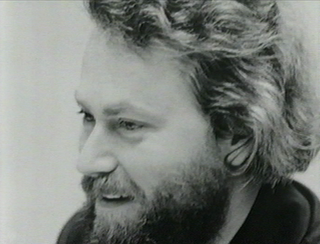
Donald Clarence Judd was an American artist associated with minimalism. In his work, Judd sought autonomy and clarity for the constructed object and the space created by it, ultimately achieving a rigorously democratic presentation without compositional hierarchy. He is generally considered the leading international exponent of "minimalism", and its most important theoretician through such writings as "Specific Objects" (1964). Judd voiced his unorthodox perception of minimalism in Arts Yearbook 8, where he says, "The new three dimensional work doesn't constitute a movement, school, or style. The common aspects are too general and too little common to define a movement. The differences are greater than the similarities."

Max Weber was a Jewish-American painter and one of the first American Cubist painters who, in later life, turned to more figurative Jewish themes in his art. He is best known today for Chinese Restaurant (1915), in the collection of the Whitney Museum of American Art, "the finest canvas of his Cubist phase," in the words of art historian Avis Berman.
Vija Celmins is a Latvian American visual artist best known for photo-realistic paintings and drawings of natural environments and phenomena such as the ocean, spider webs, star fields, and rocks. Her earlier work included pop sculptures and monochromatic representational paintings. Based in New York City, she has been the subject of over forty solo exhibitions since 1965, and major retrospectives at the Museum of Modern Art, Whitney Museum of American Art, Los Angeles County Museum of Art, San Francisco Museum of Modern Art, Institute of Contemporary Arts, London and the Centre Pompidou, Paris.
Robert Ryman was an American painter identified with the movements of monochrome painting, minimalism, and conceptual art. He was best known for abstract, white-on-white paintings. He lived and worked in New York City.

Richard Dean Tuttle is an American postminimalist artist known for his small, casual, subtle, intimate works. His art makes use of scale and line. His works span a range of formats, from sculpture, painting, drawing, printmaking, and artist’s books to installation and furniture. He lives and works in New York City, Abiquiú, New Mexico, and Mount Desert, Maine.

Alex Katz is an American figurative artist known for his paintings, sculptures, and prints. Since 1951, Katz's work has been the subject of more than 200 solo exhibitions and nearly 500 group exhibitions throughout the United States and internationally. He is well known for his large paintings, whose bold simplicity and heightened colors are considered as precursors to Pop Art.

Robert Mangold is an American minimalist artist. He is also father of film director and screenwriter James Mangold.
James McGarrell was an American painter and printmaker known for painting lush figurative interiors and landscapes.
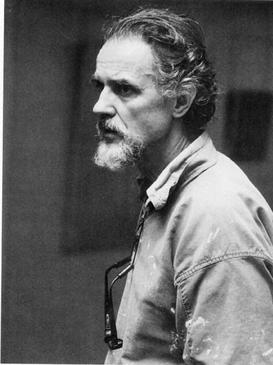
Jon Schueler was an American painter known for his large-scale, abstract compositions which evoke nature. Recognized first as a second-generation Abstract Expressionist he lived in New York City and in Mallaig, Scotland, inspired by the dramatic skies over the Sound of Sleat. His work is included in international collections such as the Scottish National Gallery of Modern Art (Edinburgh), Whitney Museum of American Art, and the National Gallery of Australia (Canberra).

Jennifer Bartlett was an American artist and novelist. She was best known for paintings and prints that combine the system-based aesthetic of conceptual art with the painterly approach of Neo-Expressionism. Many of her pieces were executed on small, square, enamel-coated steel plates that are combined in grid formations to create very large works.
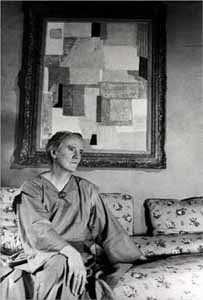
Anne Ryan (1889–1954) was an American Abstract Expressionist artist associated with the New York School. Her first contact with the New York City avant-garde came in 1941 when she joined the Atelier 17, a famous printmaking workshop that the British artist Stanley William Hayter had established in Paris in the 1930s and then brought to New York when France fell to the Nazis. The great turning point in Ryan's development occurred after the war, in 1948. She was 57 years old when she saw the collages of Kurt Schwitters at the Rose Fried Gallery, in New York City, in 1948. She right away dedicated herself to this newly discovered medium. Since Anne Ryan was a poet, according to Deborah Solomon, in Kurt Schwitters’s collages “she recognized the visual equivalent of her sonnets – discrete images packed together in an extremely compressed space.” When six years later Ryan died, her work in this medium numbered over 400 pieces.
William T. Williams is an American painter and educator. He is known for his process-based approach to painting that engages motifs drawn from personal memory and cultural narrative to create non-referential, abstract compositions. He was a Professor of Art at Brooklyn College, City University of New York from 1971 to 2008.
Lois Dodd is an American painter. Dodd was a key member of New York's postwar art scene. She played a large part and was involved in the wave of modern artists including Alex Katz and Yvonne Jacquette who explored the coast of Maine in the latter half of the 20th century.
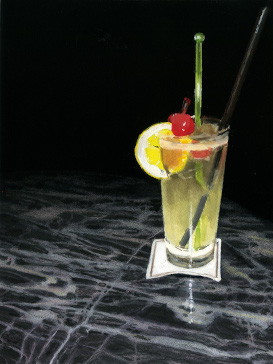
Dike Blair is a New York-based artist, writer and teacher. His art consists of two parallel bodies of work: intimate, photorealistic paintings and installation-like sculptures assembled from common objects—often exhibited together—which examine overlooked and unexceptional phenomena of daily existence in both a romantic and ironic manner. Blair emerged out of the late 1970s New York art scene, and his work relates to concurrent movements such as the Pictures Generation, Minimalism and conceptual art, while remaining distinct from and tangential to them. New York Times critic Roberta Smith places his sculpture in a "blurred category" crossing "Carl Andre with ikebana, formalist abstraction with sleek anonymous hotel rooms, talk-show sets with home furnishings showrooms." Cameron Martin writes in Artforum that the paintings are "rendered with a lucidity that extracts something metaphysical from the mundane."
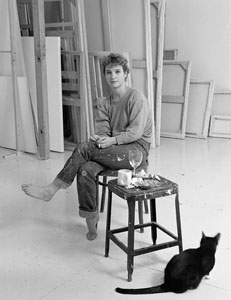
Louisa Lizbeth Chase was an American neo-expressionist painter and printmaker.
The Outlaws of Printmaking, also known as "The Outlaws" and "Outlaw Printmakers" are a collective of printmaking artists that exists internationally. The idea of "Outlaw Printmakers" formed from a show in New York at Big Cat Gallery in 2000. Tony Fitzpatrick, the owner of the Big Cat Press which is associated with the gallery, decided to call a show there "Outlaw Printmaking" to reflect attitudes of the printmakers involved in a non-academic approach to prints. As pointed out by Sean Starwars, the Southern Graphic Council print conference was happening at the same time as that show in NYC across the water in New Jersey. A handful of artists from the conference attended the show.). At that conference the core group now known as the Outlaw Printmakers formed, adopting the name from the show and continuing their own events, happenings and shows outside of the academic norm. The core members are Bill Fick, Tom Huck, The Hancock Brothers, Sean Star Wars, Dennis McNett and Cannonball Press. Many of the core artists associated with the movement cite the printmaker/artist Richard Mock as a primary influence. Mock's political and social narrative prints appeared in the New York Times op-ed pages for more than a decade in the 1980s and early 1990s. Later the group grew to include Carlos Hernandez, Drive By Press, Ryan O'Malley, Artemio Rodriguez, Kathryn Polk, Erica Walker, Derrick Riley, and Julia Curran.

Sidney Tillim was an American artist and art critic, known for his maverick painting and independent point of view on modern art in post-war America. Best remembered for his revival of history painting in the 1970s, Tillim alternated between the figurative and the abstract throughout his career. Likewise, although he wrote on a wide range of topics for Artforum and Arts Magazine, he is most identified with supporting representational art when few did.
Martha Diamond is an American artist. Her work first gained public attention in the 1980s and is included in the permanent collections of the Whitney Museum of American Art, the Museum of Modern Art, New York, and many other institutions.

Sam Glankoff was an American Abstract Expressionist and woodcut artist.











